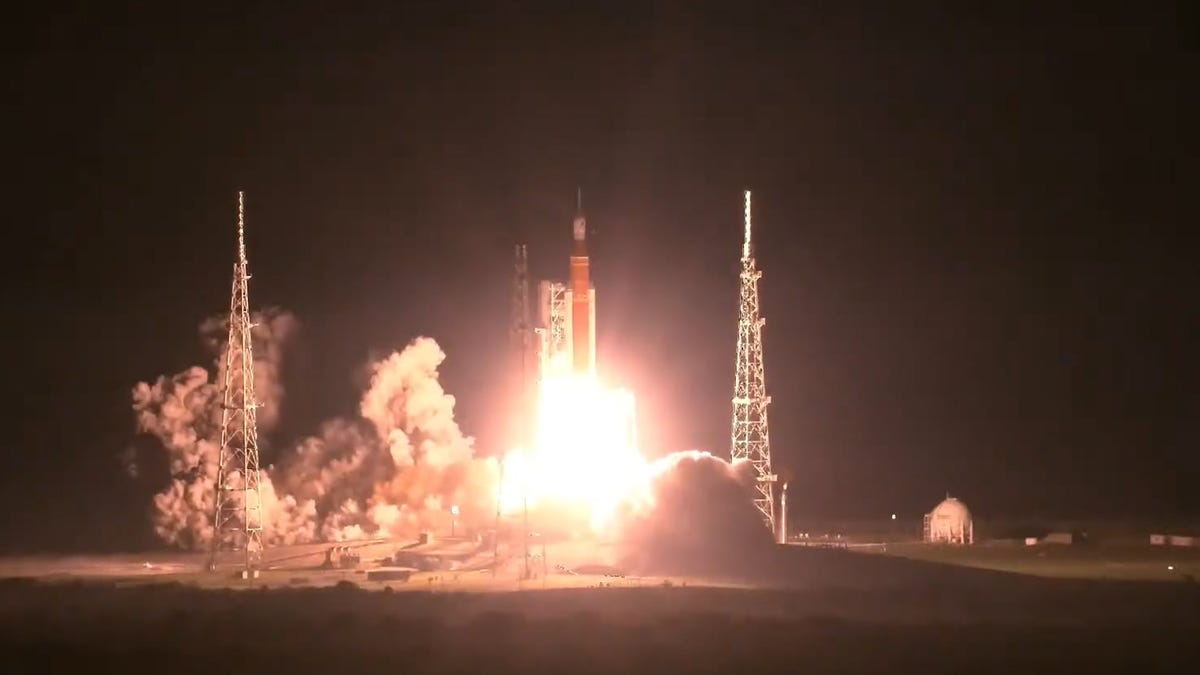NASA's Artemis I Launch Was Loud Enough to Damage Your Hearing, Even Miles Away
It didn't melt concrete, but its crackle way outperformed any breakfast cereal.

Artemis I blasts off, Nov. 16, 2022.
The first launch of NASA's Space Launch System, or SLS, on the Artemis I mission in November marked the debut of humanity's new most powerful rocket, and also one of our loudest.
SLS boasts 13% more thrust than the Saturn V rocket that took Apollo astronauts to the moon a half-century ago. Minimal sound data exists from that era, leading to a number of urban legends around the intense sound waves created by the rocket's powerful engines.
To fill that gap this time around, researchers measured the racket during the blastoff of Artemis I from Kennedy Space Center, and their data is being published Tuesday in the journal JASA Express Letters.
"We hope these early results will help prevent the spread of possible misinformation, as happened with the Saturn 5," author Kent Gee, a physics professor at Brigham Young University, said in a statement. "Numerous websites and discussion forums suggested sound levels that were far too high, with inaccurate reports of the Saturn 5's sound waves melting concrete and causing grass fires."
No concrete was melted, nor were swamps set on fire, this time around either, but there were visible pressure waves from the loud sound of engine ignition.
I clipped some footage from the #Artemis launch and WOW. Look at that pressure wave right before liftoff! (Footage courtesy: NASA) #NASA #SLS #Artemis1 #Orion pic.twitter.com/on6jpT7JEt
— Cory Smith (@wxcory) November 18, 2022
The team of researchers from BYU and Rollins College set up a total of five microphones at locations one mile (1.6 kilometers) and three miles from the launch pad. The sound picked up at all five sites exceeded predictions based on a preliminary assessment.
A mile from the pad, the roar of the SLS solid rocket boosters measured 136 decibels, which is similar to standing next to a jet engine. At three miles it still measured 129 decibels, on par with running a chainsaw. By the way, these are both things you don't really want to do without some sort of protection for your ears.
The three-mile measurement was a full 20 decibels higher than the researchers had anticipated.
"This suggests a need to revisit and probably revise those models," author Grant Hart, also from BYU, said.
Not to be overlooked is just how crackly the sound of the launch was. The instantaneous pressure increase from launch generates shock waves that come with a crackling sound.
"We found the Artemis 1 noise level at 5 km had a crackling quality about 40 million times greater than a bowl of Rice Krispies," Rollins professor Whitney Coyle explained.
Gee says the new study and its surprising findings reveal there's still more to learn about the power, and especially the noise, generated during a rocket launch.
"Although this study is an important step forward, we still have a long way to go to understand everything about the generation, propagation, and perception of rocket noise."

